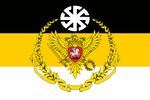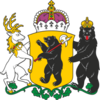Tiskaiya
This article is incomplete because it is pending further input from participants, or it is a work-in-progress by one author. Please comment on this article's talk page to share your input, comments and questions. Note: To contribute to this article, you may need to seek help from the author(s) of this page. |
The Second Tsardom of Tiskaiya Тіскаія | |
|---|---|
Anthem: God Save The Tsar! (Боже, царя, бережи!) | |
| Capital | Oryshevsk |
| Largest city | Pyatidovo |
| Official languages | Common, Tiskai |
| Ethnic groups | Tiskaiyans, Bretislavians, Qazhshavans, Krenyans |
| Religion | Orthodox Christianity |
| Demonym(s) | Tiskaiyan, Tiskai |
| Government | Tsardom |
• Tsar/Czar | Vasily II |
| Legislature | Natsional'nyy Parlament (Национальный Парламент) |
| Establishment | |
• Proclamation of the Kingdom of Sutranovka | 668 |
• Poclamation of the Kingdom of Tiskaiya | 892 |
• Proclamation of the Tiskai-Bretislav United Kingdom | 970 |
• Proclamation of the Tsardom of Tiskaiya | 1048 |
• Proclamation of the Second Tsardom of Tiskaiya | 1402 |
| Area | |
• Total | 1,121,092 km2 (432,856 sq mi) |
| Population | |
• 2018 census | 82,688,572 |
| GDP (PPP) | estimate |
• Total | 1:1.55 |
| GDP (nominal) | estimate |
• Total | $3,182,000,000,000 |
• Per capita | $38,523.00 |
| Gini | 29.2 low |
| HDI | 0.902 very high |
| Currency | Tratan (TKT) |
| Time zone | -5,-6 |
| Driving side | right |
| Calling code | +7 |
| Internet TLD | .ts |
Etymology and Terminology
When Balavaya united the region, they were given rights to name it. They settled on "Tiskaiya" after their home in the Tikaiskov Valley (Now Sutranovan Valley).
Tiskai-Bretislav United Kingdom (970-1048)
In 970, the Tsar of Tiskaiya ventured west of his lands to conquer the Bretislavian tribes. In the 8 month conquest, Beginning in January and ending in August, he successfully defeated the thirteen tribal kingdoms ruling most of Bretislavia's current lands. The young Tsar would go on to create the Tiskai-Bretislav United Kingdom. This partnership would last 78 years and somewhat thrive during his rule. Creating a united economy and social structure, leading to a mass Tiskai immigration from the dense lands of Tiskaiya to the relatively sparsely populated lands of Bretislavia. These Tiskaiyans would settle in the southeast of the country closest to their native land of Tiskaiya. To help bypass the language barrier between the early English language and Slavic language, the Tsar would allow each county to have certain freedoms regarding military, education, and other things to avoid confusion. It was only really in the southeast where early English languages were intertwined with Slavic ones. Due to the language barrier and high levels of local bureaucracy, a rivalry would grow in the late years of the Kingdom, becoming a contributing factor to the later war between the two regions.
While the difference in culture was massive, Bretislavian tribes and Tiskaiyans shared a love of militarism and bonded cultures over jousting, dueling, and hunting activities. The combination of these two cultures resulted in a culmination of western and eastern technology and medicines, boosting the countries growth but also serving to hamper it.
While the Tiskai Tsar was benevolent and chivalrous to the Bretislav people, he was still a foreign ruler. He was not the most popular figure, even in newer generations of Bretislavians, who had only known Tiskai leadership since birth. Even with the concessions made to Bretislavians by the Tsar, he never could remove the Bretislavian spirit from the region, leading to harsh military reactions by the Tsar when Bretislavians dissented against his rule and plead for a return of Bretislavian independence.
Tiskai-Bretislav War
In 1000 the Tiskai Tsars wife gave birth to a child; this child would become heir to the throne of the United Kingdom. The very same month, one week later, another child would be born. This was the result of an affair the Tsar had had with a Bretislavian servant. This son would be named Pavel or Paul (his Bretislavian name). Both sons would grow up separated, and it wasn't until 1047 when their father told them the truth and introduced the half-brothers to each other. When the Czar died in 1048, the Bretislavian son sought to free Bretislavia from Tiskaiya. After rallying Bretislavian low-nobles under his rule, he declared Independence from Tiskaiya on May 11, 1048. The Recently crowned Tiskai Tsar would quickly retaliate by raising the much more organized Tiskai army. Over the next year, brutal fighting would occur between the brother's nations, leading to thousands of deaths. It wasn't until May 1st of 1049 when the conflict would end, and the Kingdom of Bretislavia would be proclaimed.
During the year's worth of fighting, around 15,300 soldiers died, with a majority of casualties were mostly on the Bretislavian side. A majority of those aforementioned casualties occurred at the battle of Fort Bezodnya. Fort Bezodnya was a major border fort along the Tiskaiya-Bretislavia border. Stationed near and around the fort was the Army of Oryshevsk, the largest army under Tiskai control. Early in the morning, Bretislavian soldiers began to siege the fort. This siege would last 3 days before a major wall breach occurred and the soldiers were able to rush the fort's garrison.
Outside of the fort, the rest of the Bretislavian army was fighting a deadly battle with Tiskai forces not keen to lose the fort. After nine hours of fighting the armies were forced to withdraw, but with Fort Bezodnya under Bretislavian control. The next day an ambush on the fort was carried out by the Tiskai archers, who sent hundreds of arrows through the sky towards the patrolling soldiers. It wasn't long before the rest of the Tiskaiyan army came to battle with the Bretislavian army, ill-prepared for such an early battle and late to the scene. For two hours the soldiers guarding the fort would hold out from Tiskai forces until armored soldiers under the leadership of King Paul himself arrived to cut an opening for reinforcement into the fort and break through the Tiskai lines. For twelve hours the armies would fight for control well into the afternoon. Under Paul's leadership, the armored soldiers would drive out the Tiskaiyan troops from the forts surrounding area, and later a full Tiskai retreat would take place. After one week of camping out in the area surrounding the fort, the Tiskaiyan Tsar met with his brother to negotiate peace.
Post War Period
After the split with the Western Bretislavs,The First Tsardom was proclaimed, it lasted until 1086. After the Tsardom's collapse,Tiskaiya was a place of competing interests, smaller states would squabble and fight wars with each other, halting the progress of the Tiskaiyan people.
Proclamation of the Second Tsardom
The 22nd of March, 1472 marked the Proclamation of the Second Tsardom. The Kingdom of Balavaya finally had complete control over Tiskaiya. King Svetoslav IV had proclaimed the Second Tsardom, unified once more, Tiskaiya had shifted it's focus to Thaudian politics, and the growing threats of Krenya and Qazhshava (Then called Ardonia) to the South and East respectively.
1800 - 1900
This was Tiskaiya's golden age. 5 of Tiskaiya's most prestigious universities were founded during this time. Oryshevsk University, University of Pyatidovo, Trasnaya University, Fedorov University and the University of Novoshi. Literacy rates climbed to 78%, up from 43% in 1725. Tiskaiya adjusted quickly to the industrial revolution and thus cities quickly grew. A sophisticated rail system spread across the Kingdom. Quality Tiskai steel allowed for skyscrapers, and the discovery of oil in the northern desert helped everything run smoothly. Winters during this period were as mild as they have ever been allowing for extended growing seasons. Food was plentiful and people were happy.
Krenyan Wars
Tiskaiya had begun a long standing feud between itself and Krenya for many years due to Krenya's claim on southern Tiskai territory. Multiple border conflicts were fought in 1979-1982, 1984, 1991, 1999, 2005 and 2020. Tiskaiya has successfully defended its territory and Krenya has renounced all claims on Tiskaiyan land.
Entry Into the Sekidean Union
Tiskaiya had joined the Sekidean Union on it's first attempt. On the 11th of December, 2020, Tiskaiya became the 18th member of the Union. The same day as Krenya.

